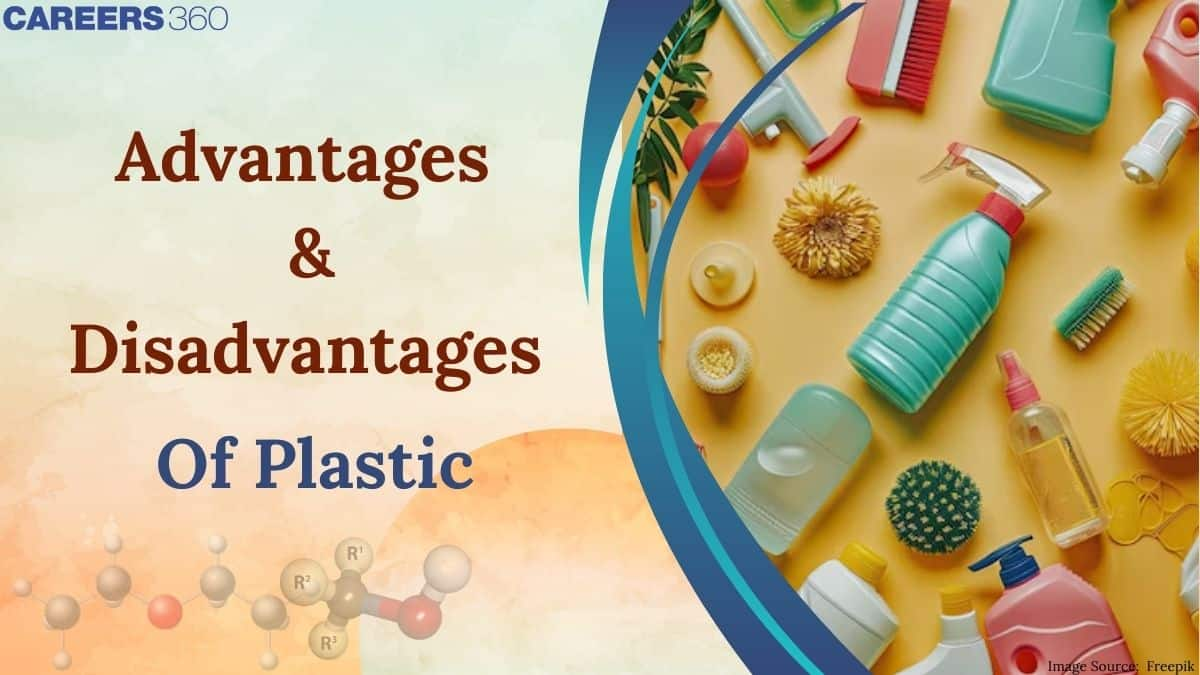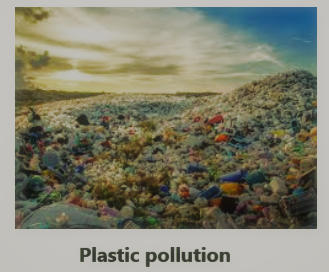Advantages and Disadvantages of Plastic
Have you ever wondered why plastics are everywhere, from packaging to medical devices? What makes plastics so lightweight and durable, allowing them to replace metals, glass, and wood in many applications? And why do they take hundreds of years to decompose, and how do they impact our health and the environment? You will get all these answers by reading this article on advantages and disadvantages of plastic.
This Story also Contains
- Advantages of Plastics
- Disadvantages of Plastics
- Some Solved Examples

Plastic is a synthetic or semi-synthetic polymer having unique properties. These materials are used in day-to-day life in a variety of applications. These plastics can be broadly categorized into 2 types, i.e., thermoplastics and thermosetting plastics. Polyethylene, PVC (polyvinyl chloride), and PS (polystyrene) are some examples of plastics used for making plastic bottles, pipes, containers, etc. In this article, students will understand the various advantages and disadvantages of plastics.
Note: The Plastic synonym is elastic.
Advantages of Plastics
There are many advantages of plastics. Some of them include
- Many plastics have a long, reusable lifespan
Plastics must not be considered a throwaway or a product for single use. Many varieties of this substance have a longer life period than or the same as other materials. A well-maintained PVC pipe has a service capacity for up to a century. The average life expectancy of the plastics used in building is 35 years. This is one of the main advantages of plastic. - The processes of plastic manufacture compare favourably with many others
Although the plastics production process can be energy-intensive using fossil fuels, it is nevertheless an environmentally friendly resource in comparison with other materials. Methods of recycling can sometimes change the comparison. The advantage remains that when frequent reuse occurs, plastics can contribute. This is another advantage of plastic. - Plastics are space-saving in facilities
Although it takes a significant length of time for plastic materials to crumble into a site, the quantity of space plastics occupy in these areas of trash disposal is modest compared with other products. The volume of paper products is seven times higher. This includes another advantage of plastic. - Due to decomposition, methane does not build up
Organic compounds release greenhouse gases when they are decomposed. This approach often focuses on carbon dioxide, but it is extremely hazardous to the methane emitted. As a reflecting atmospheric component, methane is up to 20 times more effective than CO2. When the gas breaks down, plastics do not release it; therefore, the entire life-path impact of the consequence is easier to calculate. This constitutes another main advantage of plastics. - The safe mode of delivery of all required products is plastic
Since plastic keeps the product safe, it is best to use plastic for water-containing bottles and other drinks. People use the material to get vulnerable people around the world swiftly and economically. This is the main merit of plastics. - Plastics are an inexpensive material.
- The plastics industry plays a key role in the world economy
The world's plastics business generates more than 1 trillion dollars every year.
|
Related Topics, |
Disadvantages of Plastics
There are many disadvantages to plastics
- Typically, plastics are created from non-renewable resources. While plastic initial materials originated from plant-based fibres, most of the products today are produced based on fossil fuels. It is usually petroleum, but natural gas can also be used to produce this product. About 4% of these fuels continue to be used to manufacture new goods directly into the plastics sector. If you look at the amount of resources used during the process of refinement and the predicted increase in demand, the cost of plastics to fossil fuels might approach 20% in the next decade. This is the main disadvantage of plastic.
- The pollution in the world's waters is predominantly plastic. Plastic comprises up to 80% of all marine waste. This problem is caused by marine and terrestrial sources, which often build up in broad open areas where tides come together. The problem concerns us finding rubbish on land, on beaches, and even in freshwater sources. Stirrers, bottles, cables, food wrappers, and plastic straws are some of the items that are most common items. At a cost of 5 per kg, plastic pollution is removed from the sea surface water, while the reutilization of this product is only 0.30$. This is why the efforts to clean up marine environments are spearheaded by non-profit agencies. This is another disadvantage of plastic.
- Multiple economic costs could result from plastic pollution
Pollution from plastic packaging itself causes the global economy an annual loss of over 80$ billion. It accounts for around 50% of all trash from this industry, and virtually any other industry does this in any form. Building and plastics contribute to 16% of plastic use, whereas textiles account for approximately 15%. As many of the goods are not recycled, more of them are likely to alternatively progress to waste streams. - Unable to infinitely recycle plastic products
Metals may be repeatedly recycled into a variety of different items due to the qualities of the material. This is not the chance given by plastics. Only a handful of times can people retrieve or reuse it before it loses integrity and quality. This signifies that this product is more likely to be dumped or burned in a landfill. Some plastic products cannot be recycled, and hence, the impact of this disadvantage might be further enhanced. More than 93 billion plastic objects are produced annually; therefore, they come into our waste stream. This is a demerit of plastic.

Also Read:
Some Solved Examples
Example 1: Making new containers from recycled materials like crushed glass helps to
1) Conserve materials
2) Save fuel
3) (correct) Both of these
4) None of these
Solution
Waste management -
Organic waste – composted or employed in a biogas plant.
Paper, plastic, and metals – recycled
Agricultural waste- manufacturing of paper, hardboard, animal feed, etc.
Hence, the answer is option (3).
Example 2: Which of the following is not a source of water pollution?
1) Agricultural runoff
2) Industrial discharge
3) (correct) Use of environmentally friendly products
4) Plastic Overuse
Solution
The use of environmentally friendly products helps in preventing water pollution. Agricultural runoff, industrial discharge, and domestic sewage are all major sources of water pollution.
Hence, the answer is option (3).
Example 3: Which of the following is a major advantage of plastics over metals?
A) Biodegradability
B) High density
C) Corrosion resistance
D) Poor insulating property
Solution:
Plastics are resistant to corrosion, unlike metals, which can rust or oxidize. They are also lightweight, have low density, and good insulating properties, making them suitable for multiple applications.
Hence, the answer is option (3).
Example 4: Plastics are widely used in packaging materials mainly because they are:
A) Expensive and brittle
B) Lightweight, durable, and flexible
C) Reactive with most chemicals
D) Conductors of electricity
Solution:
Plastics are preferred for packaging due to their low weight, durability, and flexibility, which reduce transportation costs and prevent product damage.
Hence, the answer is option (2).
Frequently Asked Questions (FAQs)
The plastic's qualities are corrosion and chemical resistance. They have low thermal expansion coefficients and are strongly thermal and electrically insulated. Plastic advantages are particularly waterproof, and have good adhesive properties. The production of plastic is solid, good and low cost.
Toxic chemicals leach from plastic and are found in almost all blood and tissue. Tumors, birth abnormalities, impaired immunity, endocrine system malfunction and other conditions are associated with their exposure.
Human bodies absorb chemicals on plastics. Any of these compounds have been identified as altering hormones or other potential health impacts. Wildlife can be injured or killed by plastic, chemical contamination and devoured by marine animals.
Plastics are high molecular mass manmade carbon polymers and other elements. Long monomer chains are polymers. Plastics can also be mixed and transformed into solid objects. It's utilized in boxes, packing, bags, switches, tools, power, wires, fireproof fabric etc.
Plastics are like a sponge, absorbing various hazardous substances and contaminants transported from the water. The disadvantages of plastic bags is that they contribute to a huge volume of solid waste. When we break down, we release these into the atmosphere as well as the chemicals needed to give them their properties, such as colour.
Most of the plastics break down into very tiny particles known as microplastics. These are not biodegradable.
These are plastics with a reduced or minimized environmental impact when they are produced, used, recycled, upcycled, disposed of, when they decompose, etc
Yes, the Government is taking steps towards replacing the plastic with biodegradable materials.
Polyethylene Terephthalate (PETE or PET), Polyvinyl Chloride (PVC), Acrylonitrile-Butadiene-Styrene (ABS), etc.